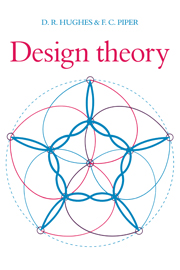7 - Some 1-designs
Published online by Cambridge University Press: 08 January 2010
Summary
Introduction
In general, 1-designs are less interesting than t-designs with t > 1; it is possible to construct them easily and there do not seem to be many deep theorems about them. But with certain extra properties imposed upon them, 1-designs can become complicated and important objects, in particular with crucial connections to group theory and geometry.
Among the most important 1-designs are generalised quadrangles, which are studied in Section 7.3 as special members of a class of 1-designs called Γα-geometries, introduced in Section 7.2. Using SR graphs we prove some elementary results about Γα-geometries, and we give some infinite families of examples. In particular, we develop two infinite families of generalised quadrangles, one classical (in the sense that it comes from a polarity of a projective geometry), the other not. The other classical generalised quadrangles involve deeper projective geometry and algebra, and we do not include them. (The surprisingly rich and complex theory of generalised quadrangles, and their connections to group theory as well as geometry, is beyond the scope of this book; some of the flavour of the subject is all that we can impart.) There are many unsolved problems (about existence, non-existence, and structure) in the area of Γα-geometries.
In Section 7.4 we study semisymmetric designs, which are 1-designs that generalise (and include) symmetric designs. Besides a number of examples, the section contains results about upper and lower bounds on the number of points in a semisymmetric design, and touches upon the many open questions in this area.
- Type
- Chapter
- Information
- Design Theory , pp. 185 - 211Publisher: Cambridge University PressPrint publication year: 1985

